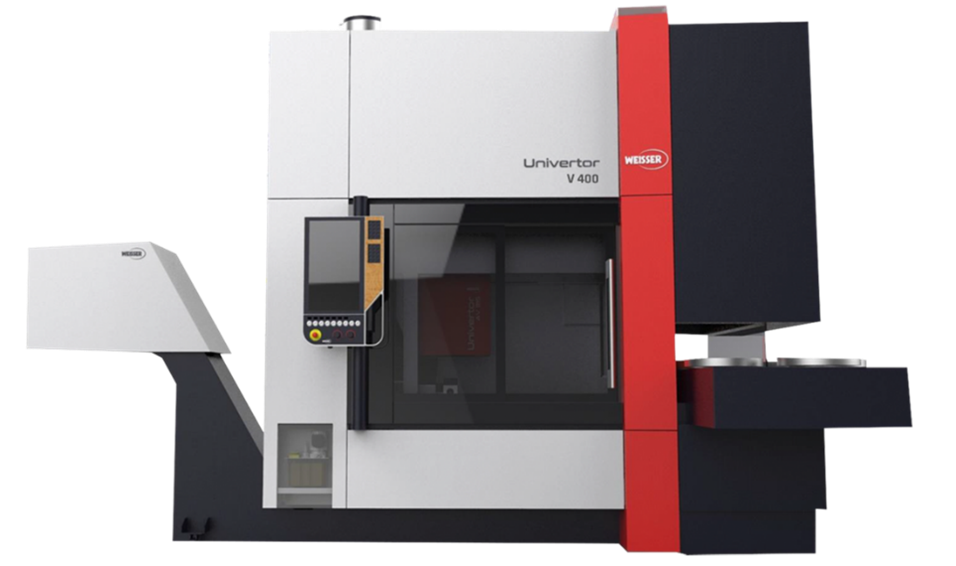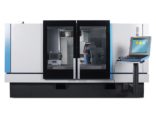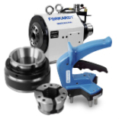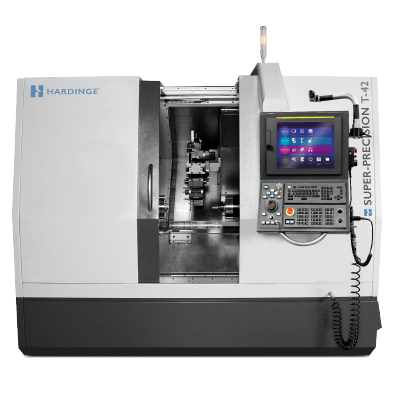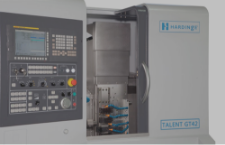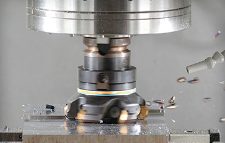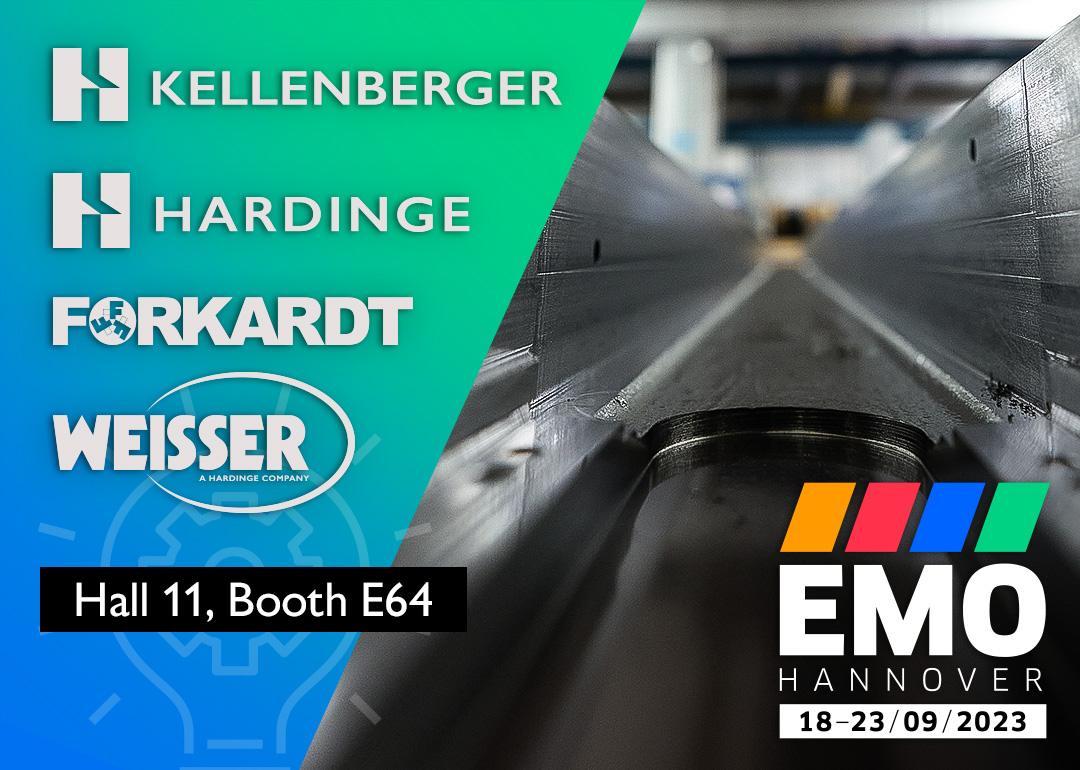Powerful machining centers and demanding applications
At this year’s EMO, the Hardinge Group presented itself with a wealth of technical innovations in the field of turning and milling.
Among other things, WEISSER presented two trade fair innovations: A horizontal 5-axis machining centre, the MultiCenter MTS 1200/8, and a manufacturing solution for machining and coating the latest generation of brake discs with the LMD BD 450 laser coating system. Hardinge demonstrated the complex manufacturing process of ceramic turning on a SUPER-PRECISION® lathe. Bridgeport was also represented at EMO with two newly developed milling machines.
WEISSER MultiCenter MTS 1200/8
The multifunctional, horizontal machining center WEISSER MultiCenter MTS 1200/8, presented for the first time at the EMO, is predestined for the complete machining of highly complex and precise workpieces from the fields of mechanical engineering, electromobility, medical technology and the aerospace industry.
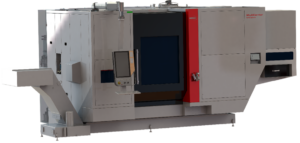
The newly developed machining center WEISSER MultiCenter MTS 1200/8 with integrated automation
The focus of the design was on maximum flexibility and user-friendliness, in addition to the best possible precision and vibration damping. The solidly designed basic mechanics in combination with 55 mm guides guarantee the best performance for demanding applications in hard and soft machining. The 600 mm X-stroke of the milling unit facilitates the use of long tools of 330 mm length. Compared to similar machine tools, the engagement depth of only 480 mm is significantly lower and ensures ergonomic access to the working area. The extra wide viewing window provides the necessary overview into the machine.
Thanks to the high degree of technology integration, there are virtually no limits to the machining spectrum. This ranges, for example, from highly complex hydraulic components to tool holders, sophisticated shafts and e-mobility components.
In addition to classic turning, milling and drilling, the machining center can also map the process technologies of rotary turning, hob peeling, gear hobbing and whirl turning. Optionally, the machine can also be equipped with a laser head for additive manufacturing.
With regard to workpiece handling, the MultiCenter MTS 1200/8 optionally offers an interesting alternative to the usually cost-intensive, external loading and unloading gantries or space-consuming robot cells. For workpieces with a maximum diameter of 160 mm and a maximum workpiece weight of 20 kg, the machining center can be optionally equipped with integrated automation. The integrated loading and unloading handling system can approach both spindle noses via NC axis and remove the workpieces by means of one gripper each for the main and counter spindle. The starting position from which the workpiece or residual piece is removed or deposited is located on the right-hand side, outside the machine tool.
Weisser LMD BD 450
Since the Euro 7 standard also regulates brake abrasion, the coating of brake discs is moving into the focus of manufacturers, because new technologies can transform conventional brake discs into wear-reduced and corrosion-resistant “low-emission break discs”. As a specialist for brake disc machining, WEISSER, in addition to the previous process chain, which includes turning, drilling and grinding, will also offer the option of laser coating in the future.
For this, WEISSER relies on so-called laser cladding, also known as laser buildup welding. In this additive manufacturing process, a material powder is blown through an inert gas into the focus of a laser beam. The powdered coating material melts in the inert gas even before it hits the likewise molten surface of the workpiece, in this case the brake disc. The result is a metallurgically bonded corrosion- and abrasion-resistant hard coating on the brake disc, with low thermal distortion. This enables the complete manufacturing solution for large-scale production of the next generation of brake discs up to Ø 450 mm by means of a cost-effective cost-per-part concept.
In the process chain, turning and drilling operations are first carried out on two UNIVERTOR AM-T vertical machining centers. This is followed by laser coating in two steps, in which first the compound layer and then the carrier layer are applied. The downstream grinding process produces the required workpiece geometry.
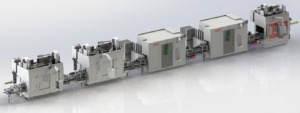
Illustration of the processing line of laser-coated brake discs of the latest generation
WEISSER UNIVERTOR V400
With the UNIVERTOR V400, WEISSER has taken proven technology a step further and expanded the well-known UNIVERTOR series.
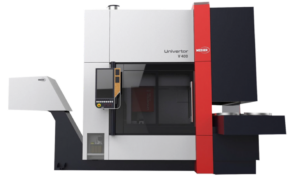
WEISSER UNIVERTOR V400
Two powerful disc turrets in combination with a 4-axis unit enable highly productive simultaneous machining and thus shortened machining times or reduced unit costs. Due to the large A8 spindles as well as the reinforced turrets, a high machine stability is ensured, which enables the most diverse manufacturing processes with the best surface quality.
The range of applications in medium and large series production covers a wide variety of materials such as cast iron, aluminum, steel as well as titanium, from brake discs, differential housings, stator housings to axle drive wheels. The heart of the UNIVERTOR V400 is the proven WEISSER Pick-Up System. This can be combined with customized automation concepts. As standard, the UNIVERTOR V400 is equipped with a cost-effective and functional drag frame conveyor.
Machining of ceramic materials on Hardinge T51 SP MSY
Due to their high hardness, wear resistance and good tribological properties, technical ceramics are used in many areas of industry, for example for plain and ball bearings or joints. In medical technology, components for heart valve pumps are made of ceramic. However, the special properties of ceramic make machining difficult and require special tools, some of which are still under development. Hardinge will be presenting the turning/finishing of difficult-to-machine ceramic materials such as silicon nitride or silicon carbide on a T51 SP MSY high-precision turning center.
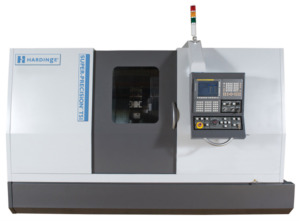
Hardinge SUPER-PRECISION® T51 SP MSY
The essential prerequisites for the successful machining of technical ceramics are the same as for hard and precision turning. Here, the SUPER-PRECISION® T51 benefits from its extremely stable design, resulting in high rigidity, speed and thermal stability. Added to this is the excellent vibration damping provided by the solid cast machine bed filled with Harcrete polymer concrete. Thanks to the vibration damping effect, better surface finishes, longer tool life and optimized process sequences are ensured. The T51 SP MSY features a powerful main spindle with a speed of 5,000 min-1 at 15 kW drive power, providing the performance needed for high-precision turning. The new ceramic turning process is highly productive and achieves surface qualities of Ra 0.2µm. It can thus replace the otherwise usual grinding in many cases.
Machining centers for large quantities in high accuracy
For industries such as aerospace, energy, automotive, mold making and shipbuilding, where the highest precision is required, Bridgeport offers the perfect solution with the newly developed V650 5AX vertical machining center. Designed for maximum performance, highly complex workpieces such as compressor blades, turbine blades for generators or high-performance fans can be manufactured using 5-axis machining.

BRIDGEPORT V650 5AX with freely accessible workspace
The V650 5AX is equipped with the powerful Siemens SINUMERIK ONE CNC control. This enables the machining of free-form surfaces under high load at maximum speed with the highest possible path accuracy. The use of the SIMATIC S7-1500 PLC reduces non-productive times and offers the best conditions for integrating the machine into higher-level automation systems.
The extremely compact design of the V650 5AX is paired with the high rigidity of the cast iron frame. The rotary table with a diameter of 650 mm has excellent vibration damping and safely accommodates workpieces with a diameter of up to 520 mm, a height of 330 mm and a weight of up to 300 kg. The protective enclosure is designed for maximum accessibility to the work area.
The motor spindle reaches a maximum speed of 15,000 min-1 and delivers 95 Nm of torque. With a drive line of 16.5 kW, the X/Y/Z axes can be moved in rapid traverse at 36 m/min. Travel distances are 620 mm along the X-axis, 520 mm along the Y-axis and 460 mm along the Z-axis. With 60 pick-up positions and double-arm grippers, the tool magazine holds tools with a diameter of 75 mm, a maximum length of 250 mm and a weight of 8 kg. With free secondary slots, tool diameters of up to 130 mm are possible.
Bridgeport XR 1000 TNC7 with Heidenhain control system
Due to its outstanding rigidity and strength, the proven Bridgeport XR 1000 vertical machining center is predestined for machining complex workpieces in the aerospace, automotive, tool and die, power engineering and oil/gas industries.
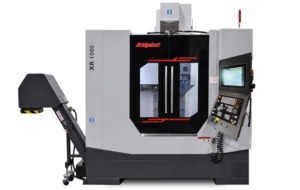
Bridgeport XR 1000
The XR 1000 is supplied as standard with a powerful direct drive spindle with 12,000 rpm and 25 kW. Other drive systems with other speed data are optionally available. The direct-coupled spindle reduces inertia and increases spindle acceleration/deceleration times, thus increasing productivity. Key features of the machine include low vibration, high power density and extreme rigidity. The absence of transverse drive forces, as a result of direct coupling, allows extremely high accuracy on the workpiece through smooth, precise spindle movement even at very low speeds.
The Bridgeport XR 1000 is equipped with the newly developed Heidenhain TNC7 control, which incorporates new machining technologies as well as strategies, and has a quad-core CPU for high computing and graphics requirements. A touch-optimized operating concept provides a perfect overview of the program, machine and workpiece. The TNC7 offers many new functions, such as graphically guided contour programming for setting up workpieces and fixtures, graphical checking of process results, and 3-D visualization of the workpiece. In the component monitoring mode, wear of the ball screw or an overload of the spindle can be detected and displayed. Integrated process monitoring for automated tasks increases safety.
In addition, further innovative trade fair novelties make a visit to the EMO booth of the Hardinge Group worthwhile. In the grinding sector, VOUMARD will be presenting a newly developed VOUMARD 30 internal grinding machine in addition to the VOUMARD 1000 internal and external grinding machine, with a grinding length of 600 mm. Kellenberger will be represented with smart automation solutions for the KELLENBERGER 100 and KELLENBERGER 1000 universal external and internal cylindrical grinding machines. In the field of clamping technology, Forkardt will present interesting solutions.

